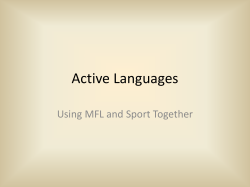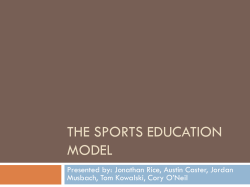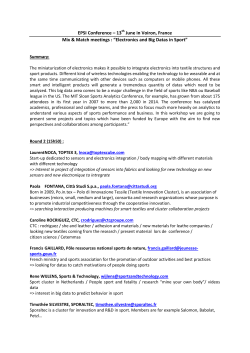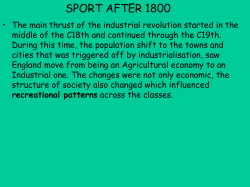
Document 406170
Making the World Safe for Capitalism: Sport, "Development" and Neo-‐Imperialism1 Professor John Nauright Professor of Sport and Leisure Cultures University of Brighton “We need to think otherwise as a condition for acting otherwise” Henry Giroux (2011) I have been researching, writing, teaching, and thinking about the role of sports in societies around the world for many years. While my initial work was in African history and political economy and shifted in the early 1990s primarily to the history of sports, I have focused more squarely on two issues over the past decade or so. The first is the political economy of sports and the ways governments, transnational organizations, and marketers use sports to sell products, services or to promote certain affiliations or practices. The second area of focus has been on the ways in which sports shape embodiment, representations of normalcy and difference, and how participants and spectators experience this through engagement with sport. In my view economic and discursive forces form complementary structuring processes. When examining the biopower generated via the operation of political economy and discursive practices in sport(s), we see it has become one of the most visible public facades of neoliberal global capitalism. Sport, while having the possibility of promoting resistance and individual and social transformation, has become more and more enmeshed in a global system based on growth and inequality at the expense of sustainability and social and economic justice.2 Out of these two areas of interest, my research and teaching over the past several years has been applied to issues surrounding sport mega-events on the one hand, and sport and international development issues on the other. While both are shrouded in a language of healthy lifestyles that can be achieved in and through sports, at elite and grassroots level sport is increasingly less about health and more about the creation of consumers in and through sports and generating profit from related products and services. In general, events such as the Olympic Games, the Commonwealth Games, the FIFA or Rugby World Cups and Continental Championships in soccer – have gained greater significance due, in large part, to an expansion of global media markets, new technologies enabling greater exposure to be achieved, and the profits generated by the 1984 Olympic Games in Los Angeles, which began the move towards the notion of mega-events as economic drivers. 3 As a result, many countries began to link their economic development strategies to the attraction of major international sporting events 2 that they hoped could leverage exposure into an increase in tourism income and outside business investment while encouraging the rapid development of supporting infrastructure that could be used more widely post-event. Therefore, even though megasporting events are vulnerable to imprecise impact studies and much ambiguity exists with the meaning of the concept of “legacy,” it is a reality that a continually growing number of cities and nations compete to host large-scale events.4 Governments are often keen advocates for promoting the positive impact that these events have, not only on a country’s economy, but also on its developmental legacy. While political factors form the power behind the willingness to host mega-events, the hosting itself, beside the usually advertised economic and ‘image’ impacts, can have a variety of social consequences. Examples of social costs that impact local day-to-day life include: traffic congestion and overcrowding of roads; increased potential for criminal activity; disruption to daily schedules; and increased pollution. Protests in Rio de Janeiro in June 2013 brought these into sharp relief for a global audience, though such opposition is normally held at bay through draconian legislation and the militarization of public space. The political willingness to host mega-events can, therefore, involuntarily (or not), ignore negative consequences faced by the local community/region/nation such as residential displacement, breakdown of historic communities, and cost overruns that impact negatively upon citizens’ quality of life. Various estimates suggest that a minimum of one million and upwards of two million or more people will be displaced in Rio de Janeiro as a result of that city being one of the locales for the 2014 FIFA World Cup and then host of the 2016 Summer Olympic Games. Host nations and cities work to establish a sanitized space where imagined visions can be projected to spectators and the global community, thus unsightly landscapes and undesirable people are removed or relocated.5 Boosterist politicians and business leaders aided by complicit corporatized media within host nations promote sports mega events as the expression of national selfworth and tout the benefits of being generous hosts to the global community. The notion that sport is somehow apolitical or moral has infused discourses urging participation for the sake of enjoyment or fun. The history of modern sporting forms and organizations, however, demonstrates clearly that sports have become key components of the public relations machine whereby public discourses reify the wonders of capitalist accumulation and growth as the only legitimate path to development and measure of success.6 In developing my critique, I have explored the emergence of globalized sport in parallel with the development of corporate capitalism and examine sport as a legitimating institution that has done little to challenge the dominant world system propagated by the West and North and spread through the imperial and neoimperial mechanisms of conquest, economic control and political intervention. The Olympic Games provide a prime example of complexities in utilizing megaevents as economic development strategies to promote the common good. The concept associated with the creation of the Olympic Games in the latter 19th century was associated with the perpetuation of class distinction while shrouding the games with an 3 aura of universalism and healthy, fit and youthful bodily display. Alternative international sporting movements were marginalized -- such as the “Worker Olympics” and “Women’s Olympics” of the 1920s and 1930s -- as the governing body for the Games, supported by business and governmental elites established control of the governance and operation of global sport. The rise of neo-liberal economic strategies in the West in the 1980s enabled the Olympic “Movement” as a single institution with the capital to organize events, to define, delineate, and sustain particular meanings about sport and human society to tie human aspirations to economic development issues. In addition, the hegemonic ideology of Olympism has been coupled with a financial capitalist ideology through association with transnational corporations. Thus, megaevents exist to legitimate political, economic, diplomatic and militaristic institutions that support and gain benefit from them. At the same time, competition in sports event production has led corporate interests to demand that event organizers demonstrate value or return on investment resulting from sponsorship and public exposure. Olympic Games, ultimately, are more about selling consumer processes and dominant political ideologies than about promoting peace and social justice. The Games are political; they always have been. Unfortunately, the disturbing testimony to their success is that most people don’t complain about distortions of the “ideals” of sport, and in fact actively support the Games. Thus it is important to understand the “manufacturing of consent” that occurs in the production of support for capitalist-driven sport. As Canadian labor historian Bryan Palmer argues “there are no ties that bind as effectively as those that are self-imposed, those that appear in the historical record of oppression and exploitation at the request of the very people they will secure.”7 Most people happily support major sporting events even when it is against their short and long-term economic interests. Even in the face of readily available evidence demonstrating the horrible living and working conditions of most workers who produce the goods consumed in and around sports and sporting events and in the face of forced removals, cost overruns, increase taxation, the suppression of democratic rights and freedoms, like Avery Brundage we happily announce “the Games must go on” enjoying our orgy of nationalist celebration, stories of triumph against adversity and consume the products proclaiming loyalty to the nation and the brand of sport/event on offer. The Olympics has been historically linked to the process of modern capitalist development throughout its history, and since the 1980s, has been rejuvenated by neoliberalism and its connected globalization processes in a context of total monopoly of the ownership of the concepts and values that have defined and sustained dominant interpretations of “sport.” FIFA’s recent decision to send its global extravaganza World Cup event to Russia in 2018 and Qatar in 2022 clearly demonstrates that the world’s leading sports organizations are selling to the highest bidder and that countries willing to prostrate themselves fully to organizations such as the IOC and FIFA are the ones most likely to be given the right to host the flagship events of the Olympic Games and the FIFA World Cup. The stakes have been raised higher and higher in the past decade as countries from Africa to South America to Australia and Asia have begun to vie for the scarce commodity of global mega-sporting events. 4 It is often taken as a given that Australian public was uniformly supportive of Sydney 2000, yet there was a concerted effort of manufacturing consent led by the governments of Australia and New South Wales and there corporate Olympic sponsor allies. Prime Minister John Howard famously argued, “to criticize the Olympics is unAustralian.” Such a statement was a total ahistorical fallacy in a country noted not only for sporting prowess, but also for scepticism in the face of authority. Consent was further manufactured through the corporate invasion of the classroom disguised as “Olympic education.” Corporate sponsored and Olympic organization approved curriculum was delivered to New South Wales schools as children were taught the values of “Olympism” and the virtues of the corporate supporters of the Games. However, the Olympics were held at a social cost yet to be fully measured. Douglas Booth noted in “Swimming with the Big Boys” that the very day in 1993 Sydney won the right to host the 2000 Olympics the NSW government announced the closing of hospital wards and cuts in educational funding (Booth, 1994). Many academics jumped onto the Olympic gravy train despite knowing the social and economic costs of the event. At the 1997 conference of the Australian Society for Sport History a session was held on how ASSH and ASSH members could capitalize on the Games being in Australia. This was the most contentious session in ASSH history in which the pro-olympist group argued the Games should be leveraged for maximum benefit, while others argued passionately for maintaining independent analysis that allowed for critical debate.8 In 1999, however, ASSH was hosted by a member of the critical analysis group and focused on the question “The End of Sport History?” which included several feature speaker sessions I chaired and included international speakers such as historian Tony Mangan and sociologist David Andrews. The end of sport history debate was indeed a more constructive one for an academic society with some members moving towards a critical pedagogy stance, though that segment remains a minority of researchers in sports history. Countries with a much lower level of global visibility than Australia, China or the United Kingdom, particularly in the Global South, face an increasingly uphill battle as the global sport–media–tourism complex solidifies around large events with widespread interest. An events-driven global economy favors the already wealthy nations that can afford the levels of investment necessary to attract such events. To illustrate income inequalities we should note that the total annual income of Tiger Woods as far back as 2003 was $76.6 million, while Bhutan’s national Gross Domestic Product that year amounted to $68 million (Nauright, 2004). Multi-year baseball, basketball, American football and European soccer contracts now surpass gross domestic products of countries such as Belize and Botswana, and this is money paid to a single athlete. The value of leading sport franchises such as Real Madrid, Manchester United, or the New York Yankees exceeds the GDP of many developing nations such as Paraguay, Honduras or Zambia to name but a few. Currently, Real Madrid is the world’s most valuable soccer club at $3.3 billion, just ahead of Manchester United at $3.17 billion, and Barcelona at $2.6 billion (Forbes, 2013) The New York Yankees lead the American list at $2.3 billion. These clubs are more valuable than the total national economies of many nations with Real Madrid now worth more than the national economies of nearly 40 nations. 5 With elite commodified sports having such large economic values, they become significant power players in regional and national political economies. Local community interests and democratic practices are often subverted as business and governments align in support of events-driven economies as part of pro-growth strategies. In substance, business and political leaders view sports mega-events as significant channels for local and regional economic development and as a way to facilitate urban redevelopment using the event as a catalyst to leverage additional resources that they argue might not otherwise be as forthcoming. This strategy is justified through projecting tourism growth, touting resulting infrastructural improvements, and the generation of short-term employment opportunities. Tourism and envisaged new investment in the specific locality or nation are key aspects of the heightened interest in hosting mega-events as they are thought to be the most expedient way to attract media interest in a host city or nation, which, it is hoped, will translate into an influx of outside capital through tourism and new investment. Sports critic, Marc Perelman suggests there is now an entire mode of production that has emerged around globalized sport. 9 Several sociologists of globalization and sport, notably George Sage, make a similar if slightly less bold argument about the increasing potency of sports in global capitalism. In addition to economic issues, mega events also must to be understood from political and social viewpoints, because mega-events involve the political leadership of a host country and often shape legacies that governments and leaders envision for themselves. Governments are often keen advocates for promoting the positive impact that these events have, not only on a country’s economy, but also on its developmental legacy. While political factors form the power behind the willingness to host mega-events, the hosting itself, beside the usually advertised economic and ‘image’ impacts, can have a variety of social consequences. Examples of social costs that impact local day-to-day life include: traffic congestion and overcrowding of roads; increased potential for criminal activity; disruption to daily schedules; and increased pollution. The political willingness to host mega-events can, therefore, involuntarily (or not), ignore negative consequences faced by local communities such as residential displacement, breakdown of historic communities, and cost overruns that impact negatively upon citizens’ quality of life. Host nations and cities work to establish a sanitized space where imagined visions can be projected to spectators and the global community. Boosterist politicians and business leaders through the media within host nations promote sports mega events as the expression of national self-worth and tout the benefits of being generous hosts to the global community. When the IOC announced on 7 September 1997 that Greece had won the right to host the 2004 Summer Olympic Games, a few Greeks on the political left warned that the Games would be financed by “debt” that future generations of Greeks would be paying.10 Nobody apart from some in the far left party of Greece took notice of these prophetic words. The Games were coming ‘home’ and the Greek people were mesmerized – 6 national sentiment ran high. Coupled with this wave of nationalism it was envisaged that there would be real financial benefits for the country. After the failure to win the right to host the centenary Olympic Games of 1996, the Greek Government embarked on a path of debt fuelled spending to produce an excellent Olympic Games. This was particularly important since then IOC President Juan Antonio Samaranch had genuinely declared the 2000 Sydney Olympic Summer Games as the “best ever” in terms of organization and delivery so the expectations bar had been raised to new heights. The specter of hosting one of the two premier global sports events, and one that is indelibly tied to Greek history, was attractive both to most Greeks as well as for the IOC. Despite this allure, hosting the Olympic Games is a high risk venture where some, most notably Montreal in 1976, have failed to deliver projected economic and social benefits, while others have been successful economically (Los Angeles 1984) or in terms of legacies for the cities and citizens (Barcelona 1992; Sydney 2000). For the Greek Government a mediocre 2004 Olympics was not an option. Success could revitalize the image of Greece around the world. The timing of Greece’s entry into the European Monetary Union in 2001 was not coincidental; progress on the Athens Games was progressing behind schedule and criticism came from both inside and outside the country. Between 2000 and 2004 the majority of Olympic preparations took place. The Athens Organizing Committee was given an open-check book and entry into the European Union allowed for easier financing than was previously possible. This cheaper and easier ways of financing and borrowing had the effect of making the Government less responsible particularly as the thinking was the Games would stimulate tourism and outside investment in Greece thus recouping the debt financing that was undertaken (Georgiakis & Nauright, 2012). Public investment in sports facilities is justifiable if the net benefits are greater that the cost of alternative uses. For Athens most of the venues, which had very high maintenance and operating costs, had very little practical use and have not been utilized post-Olympics. Many of them are deserted and the most striking example is the Olympic village, which, located six miles from the centre of Athens, lies unused. Housing more than 10,000 athletes in 2004 it is now reminiscent of a ghost town from an old western movie. There are also a number of other fields and courses (judo, hockey, table tennis, canoe and kayak), which are also not being used. The canoe and kayak course was supposed to be turned into a water theme park. Even though these facilities were officially designed with a post-Olympics plan, it became very clear after the Games, that this plan in reality was never conceptualized fully let alone implemented (Georgiakis & Nauright). In Cape Town, South Africa, it is likely that the showpiece stadium built near the waterfront at the foot of Table Mountain for the 2010 FIFA World Cup will be demolished in the near future due to high costs of maintenance and chronic underuse of the facility even after its post-World Cup capacity was reduced from 68,000 to 52,000. The subversion of democratic practices and public transparency I alluded to earlier were evident in South Africa in the lead up to the World Cup. In examining the covert government led management practices in the city of Durban, for example, it is clear that the building of Moses Mabhida stadium was part of a larger and secretive plan 7 involving Durban municipal manager Michael Sutcliffe who managed the city’s 2010 build-up. While a new stadium in Durban was ‘nice to have’, it was not a FIFA requirement for hosting matches. The new stadium displaced spending that was badly needed elsewhere, but was constructed with a view to a future Olympic bid and as part of a massive urban beachfront redevelopment focused on increasing tourism and high-end leisure activities. The Durban beachfront urban renewal has greatly enhanced the image of Durban and the space is now widely used in sport/leisure activities across its length from Moses Mabhida stadium to the area of uShaka Marine World. Many community members have used the space, though few infrastructural investments were made to the areas where the consumers live in the numerous impoverished areas in and around the city. Embracing an almost exclusive neo-liberal, market-orientated approach, the idea among advocates of the FIFA World Cup was to position cities like Johannesburg, Durban, and Cape Town among a global hierarchy of competitive metropolitan areas. Yet, evidence from previous such events suggest that the results of hosting do not deliver on the promise of widespread community benefit. Basic infrastructure remains poor to non-existent for the majority of the population in those cities, unemployment is rampant, and crime is prevalent (cf. Giampiccoli, Lee & Nauright, 2013). In the lead up to the Sydney 2000 and London 2012 Olympics, democratically elected governments enacted Olympic related legislation that restricted public freedoms and rights and protected Olympic sponsors and Olympic related logos, signs and phrases in draconian fashion to satisfy the International Olympic Committee’s (IOC) requirements. Former Australian Prime Minister John Howard argued in the 1990s that criticism of the Olympics was “un-Australian” in efforts to minimize protests against the requirements for Sydney 2000 and the country had to implement to satisfy the IOC. Protest and vigorous debate are hallmarks of the Australian tradition. Similarly in Britain, the London Olympic Games and Paralympic Games Act of 2006 exacted even tighter control over what can and cannot be done or said in the lead-up to the event and during the event itself. Who benefited from the London Olympics? We know for sure that the IOC and its group of elite global corporate sponsors will top the list. Today sport appears more and more popular yet less and less accessible to the masses as corporate boxes and specialized event tourist packages price events beyond the means of the average citizen.11 As of early 2013, the showpiece Joao Havalange Stadium in Sao Paulo is closed in and disrepair less than a year and a half out from the World Cup. If Brazil with its vast and rapidly increasing economic resources struggles, if the United Kingdom subverts its own laws in order to host the London Games, if the Greek economy collapses in part due to the overspending and poor policy planning and implementation surrounding the Olympics, if South Africa spends millions to build a useless stadium to present the television images FIFA demands, where does that leave the vast majority of nations and cities around the world striving to get “on the map” through sports? 8 As global sports organizations have developed into a global governance system tying individual athletes to regional and national associations affiliated to international bodies linked to the Olympic Movement what has been done in the academic sports sciences? Around the world, scientific study of sports from physiology to management and marketing have supported the global sports system as elite athletes are trained to go faster, higher, stronger while others sell their talents to teams, sponsors and the media. Some historians and many sociologists studying sport have challenged the current system demonstrating the inequalities that it produces in humanistic terms particularly as sport has become mapped onto the human body. While the majority of academic programs around the world continue to “train” students to become sport coaches, psychologists, athletic trainers, sport managers etc, a few are beginning to challenge the primacy of elite sport and suggest that a physical cultural studies approach and one that is more centered on health and fitness rather than sport performance is a more sustainable future for the study of human movement and one centered within critical pedagogy that can claim a transformative future for democratic societies beginning with the freedom of expression through the joy of movement. Sadly many who advocate this view are tucked away in departments where “training” of sports and fitness professionals is paramount. This is not an easy journey as it largely runs counter to conventional wisdom of global neoliberal capitalism whereby universities in general and academic programs in particular have become increasingly commodified and have moved more and more towards training institutions for the service of global capital or what the British government cleverly calls “knowledge transfer.” Henry Giroux puts it this way: “Within the ongoing logic of neoliberalism, teaching and learning are removed from the discourse of democracy and civic culture and defined in often narrow instrumental and methodological terms. Increasingly stripped of its civic function, education becomes merely a matter of training and removed from any notion of power, critique, or imaginative inquiry” (Giroux, 2011: 68). Following Giroux, we might advocate for “knowledge transformation” rather than settling merely for knowledge transfer. Even the shift of some kinesiology and human movement studies departments to a foregrounding of health and fitness has not led to much in the way of critical pedagogy strategies being infused into the curriculum. The balance between sports science and coaching programs linked to the training and support of elite athletes and those exploring fitness across the lifespan issues has not altered the fundamental dominant knowledge bases in these programs which has recently been labeled by Andrews and Silk as “McKinesiology” (Andrews & Silk, forthcoming). However, there is one new “hot topic” area many departments are embracing, promoted by sport management and sociology of sport colleagues. This area is sport and international development. Yet, even within this area originally conceived as a way to “do good” in and through sport, there is much debate as to what the aims and objectives are and should be. Rather than simply viewing sport and development as another area in which to train students for sporting careers, this area offers the potential for a re-centering of sport in the academy as a transformative practice. However, if ill-conceived, sport and international 9 development/sport and youth development runs the risk of perpetuating the problem creating by neoliberal capitalism and its associated sporting enterprises rather than offering alternatives that include strengthening democracy, enhancing quality of life through health and fitness, and contributing to community-based sustainable economic futures. It is important to understand historical frameworks of global power and processes that begin in the imperial/colonial era whereby Western body culture practices were inscribed onto colonial bodies replacing and subverting local physical cultural practices in order to understand better why contemporary sport development in the Global South is often viewed as a form of neocolonialism or neo-imperialism. In the latter part of the nineteenth century, precisely during the period when modern sports were codified and organized and new modern scientific disciplines were emerging, Western nations divided much of the rest of the world into colonial territories, and Africa in particular was completely allocated among European powers who drew arbitrary boundaries that had little to nothing to do with African state formation already in progress. Thus colonial territories such as “Kenya” were written onto the African landscape by Europeans. European colonizers sought to conquer their new territories and compare and contrast what they found with their own societies. To fulfill their scientific mission, the spoils of Empire were shipped back to the colonial center, and, once interpreted, placed on public display in museums, zoos and international and travelling exhibitions. Exhibiting colonial exotica allowed those at “home” to experience faraway places and mysterious cultures and peoples in a process David Cannadine has called “ornamentalism” (Cannadine, 2009). Displaying native peoples as exotic, primitive, or backward confirmed and legitimated Western colonial expansion and conquest as the “white man’s burden” to bring “civilization” to the rest of the world. The civilizing mission was supported by a biological imperative (Shilling, 1993, p. 57) and thus the body became the primary site where the construction of the exotic Other occurred. As Z.S. Strother (1999: 37) argues “The body became the signifier of the real, the authentic. Its choreographed presence validated the colonial imagination.” The Western Gaze over a long period of time was trained to see the African body as Other and different, labeled “wild” and “primitive.” Empire became a place where white men could seek adventure and profit. A literature of colonial adventure and fantasy emerged including works of Rudyard Kipling, Joseph Conrad, H. Rider Haggard, and Edgar Rice Burroughs and other adventure stories aimed at boys. Indeed, in some colonial settings where whites had settled, physical prowess began to exceed that of British men as Australian cricketers in the late 1870s and 1880s and New Zealand, South African and Australian rugby players in the first decade of the 1900s achieved sporting success against the “mother country” (Nauright, 1996). Fictional characters such as Alan Quartermain and Tarzan (1912) demonstrated the power of the white man to dominate nature and the local population (Tarzan was an ecotourist) while fantastic images of the wild and primitive warrior, most particularly the Zulu, created an Other against which such heroes could be read (Carton & Nauright). Tarzan first 10 appeared in literature in 1912 but was translated onto the motion picture screen by the 1930s played by American Olympic swimming champion Johnny Weismuller playing the “Lord of the Jungle” in 12 movies (Tarzan eco-tourist) Zulu-themed toys appeared in the USA by this time and Africa became part of an American fantasy already framed by cowboy versus indian “Westerns” which aided in legitimating an American world view little different from that of Western Europe. What has all of this got to do with sport and international development? Quite a lot in fact. John Bale outlines in the opening of his book Imagined Olympians (which examines European framing of the Tutsi physical cultural practice of gusimbuka urukiramende in terms of Western high jumping), how in November 1995 then British Prime Minister John Major supported a scheme to send “sporting missionaries” to Africa. Major and others argued the continent held a vast reserve army of athletic talent that could be used a sports labor in the global sports economy. In reporting on Major’s idea, the London Times illustrated the story with a photograph of a Tutsi man jumping over the heads of two white men. As Bale states: The photograph represented part of what the author described as ‘plenty of treasure [that was] to be found’ in late twentieth-century Africa. It communicated an image of African athleticism, and it was taken in 1907. The late twentieth-century article that accompanied the photo implied the need for the more civilized Europe to rescue African athletes from their primitive conditions by giving them the gift of Western sports. In this way they could be taken to a place where their skills could be appreciated and used. (Bale, p. xvii). Bale argues that the representation of African body cultures by Europeans was as significant as actual colonial rule in generating perceptions of ‘Africa’ both on the continent and globally. Bale refers to ‘Africanism’, drawing upon Edward Said’s concept of ‘Orientalism’, to explain a Western style that makes statements about Africa: “representing Africa in a style for dominating, restructuring, and, often, having authority over it.” Bale argues further that while there are a number of works that discuss sport and empire, “they are characterized by an unwillingness to attempt an excavation of colonial representations of pre-colonial movement cultures.” In presenting a number of illustrations of gusimbuka, Bale states that these produced a variety of ways of seeing Africa and the African: “as exotic, mysterious, powerful – and as athletic [emphasis added].” However, Bale reminds us that within Rwanda itself, the result of representations of Tutsi body culture led to them being viewed as a super ‘race’ of athletic bodies shaped in European discourse, and, by implication, the Hutu were different or inferior as they did not have a similar body culture tradition. Here Bale touches on a crucial point that requires further analysis in the history of sport in Africa. We have to begin to unravel the impact of sport, colonialism and representation on different groups within various locales in Africa as well as between ‘African’ and ‘European’. 11 Through its early links to the global imperial project and the emergence of a sports science that has often been used to compare bodies against a white male norm, the modern Olympics has contributed to the cultural colonization of the world in the name of elitist achievement sport and Western capitalism. At the same time, the Olympic Movement has attempted to shroud this process in the ideologies of Olympism, “fair play” and global inclusivity and universalism. Like other transnational or global movements the Olympic Movement has attempted to become a “world system.” Projects including Olympic Aid and Olympic Solidarity, and other efforts to deliver it sporting activities and technologies to non-Western nations, directly parallel efforts to produce an undifferentiated global consumer. In Africa, the body was central to the imperial project though as much through the ways in which class was read onto the colonial body as race. Participation in modern sport was viewed as part of ‘civilized’ development and the ‘civilizing’ project, which was centered on the adoption of Western styles of dress and bodily deportment.12 Those Africans who adopted Western dress, attitudes and sports were accepted as junior partners in the colonial hierarchy while those who remained uneducated or involved in ‘traditional’ activities were viewed differently. The colonial project hinged on the support of traditional hierarchies and class and cultural distinctions, though it could by no means control the outcome once sport was unleashed on the rapidly increasing urban masses in Johannesburg, Durban, Brazzaville, Leopoldville, Lusaka, Nairobi or Lagos. The moralizing of leisure time and ideals of controlled development and capacity building still informs much of development discourse today and is still being written over the top of local physical cultures. It has come, however, with the realization that “development” as sold to the Global South over the past half century has not succeeded in reducing the gap between rich and poor nations. Indeed, the chasm has widened. Thus other means for achieving greater capacity and debates about growth versus sustainability have led to culture, environmental stewardship and sport as areas where “development” could best be promoted. Since 2003, the United Nations (UN) has advocated for sport as a development tool. The UN declaration of 2005 as the Year of Sport and Physical Education provided an official endorsement of sport as a technology that could contribute, among other things, to development, peace, local development, cultural understanding and the achievement of the Millennium Development Goals (MDGs) (Coalter, 2010: 1374). Sport for development has been analyzed in different ways from large event impacts and legacy to local contexts and any correlation between the two.13 For examples in the South African context: Tomlinson, Bass, and Pillay’s (2009) edited book Development and Dreams explored the likely development legacies of the 2010 World Cup.14 With UN legitimation and an increasing awareness on the part of the IOC, FIFA and leading clubs and leagues around the world, sport and international development has mushroomed as an area of both practice and study. 12 Ambiguity in the relationship between sport and development should, therefore, be examined. As such “questions about how to understand the relationships between forms of sport, forms of organization, types of social capital and forms of development, or the extent to which such relationships can exist” (Coalter, 2010:1386) should be explored. Levermore (189) states that “[t]here is clearly potential for sport to be used as a new engine in advancing various dimensions of development, something grasped by a growing number of policy makers. However, more evaluation is required to determine the exact nature of its potential.” The use of soccer as a development and humanitarian tool has been present since at least the early 1970s (Manzo, 2001:551).15 Soccer can be exploited for various and diverse aims. Many NGOs specifically endorse football in as a development tool. (Examples include: Grassroots Soccer, Streetfootballworld, Play Soccer, Right to Play). Sport in development has been relevant in peace building and as a tool to fight racism and ease ethnic tensions (Mchombo, 2006:320). Sport development to enhance life skills has also been widely tauted (Jones and Lavallee, 2009). In specific relation to soccer, studies have investigated the role of coaches in developing life skills among their players (Gould et a., 2007). Authors have cautioned, however, that linking sports development with sports mega-events and transnational sporting organizations may not be sustainable and in fact may be detrimental or divert money into showpiece projects that have little use value to local populations. Two examples should suffice. In St. Lucia, FIFA provided the funding for a new soccer stadium complete with FIFA standard field. Unfortunately the stadium is now used as a hospital since it sits on the south of the island near the international airport, but is nearly two hours drive from the major population centers of the impoverished island. In South Africa, many showpiece soccer initiatives were displayed in the two years leading up to the World Cup and during 2010. These were nearly all located in the metropolitan regions of the three largest cities of Johannesburg, Durban and Cape Town, areas already receiving the bulk of aid and infrastructural inputs. The rest of the country by contrast has fallen further behind those regions leading to increased in-migration and greater disparities between regions within the country. Cautionary Comments about the Rush to do Sport as “Development” As I have suggested, in its current practice at elite professional and mega-event level and as promoted a sold as “development,” sport(s) offers little that challenges neoliberal economics and, as operated in the developing world (mostly in what we would call the Global South), promotes a neo- imperialism that perpetuates inequalities generate in the era of imperialism/colonialism. While I am skeptical about the possibility of real change in and through sport, I suggest there are alternatives whereby sport can promote sustainable futures and challenge the status quo. I hope to at least open up debate whereby challenges to the practice of accepted norms such as “olympism,” “development,” and “character building” might be decoded and recast particularly in terms of how we view sport pedagogically and how we envisage sport as a vehicle for 13 social and economic “development” in spaces of the Global South and marginalized spaces of the Global North. My skepticism is largely shaped by the structural forces shaping the global economy. As deindustrialization practices have accelerated over the past 30 years production has shifted from developed to less developed societies. This process has been explored in detail for the sporting goods industry by George Sage. Sage demonstrates how low cost labor and poor working conditions shape an industry that has now become a global system where “they work while we play.” Playfair 2012, a group that monitored the labor conditions surrounding the London 2012 Olympic Summer Games, found evidence of child labor, poor working and living conditions, poverty wages, and draconian work discipline at the Chinese factories manufacturing pins, badges and London 2012 mascot dolls. This led to some changes on the part of the London 2012 Organising Committee, though these came late in the day and made little difference to the lives of those producing these prized souvenirs. However, sustained activism can make a difference. United Students Against Sweatships (USAS) has partnered with Asian workers exploited and then abandoned by adidas to campaign for their universities to end their athletic sponsorship contracts with the sporting goods giant. As of 20 April 2013, 15 universities had responded to the USAS “Badidas” campaign. Earlier campaigns highlighted sweatshop practices by Nike that violated Indonesian labor laws and some universities also ended their contracts with Nike. As a result Nike eventually listened and amended some of their practices. These efforts are mere starting points in the campaign to promote health in and through sports and fitness around the world. It is impossible to suggest that sport and physical activity are social goods, if the only social good it serves are middle and upper class interests in advanced capitalist societies. Concluding Thoughts: Making the World Safe for Capitalism? Constraints and Opportunities for Physical Cultural Studies Given the history of modern sport and associated physical cultural practices, practices firmly situated within the development of modern industrial and post-industrial capitalism and the supporting political regimes of imperialism and colonialism, what interventions can and should be made by those of us interested in fitness and sport? The first and fundamental principle is that the right to health and to participate in physical activities has to be promoted as a fundamental human right as has been advocated by the UN and stated by transnational organizations including the European Union. Interjecting our voices into public debates about health care, safety in public space and promotion of issues that enhance social justice are not only local issues, they are national and global ones. In our research, in our pedagogical practice in the classroom and online, and in connection with professionals “in the field,” we must become active critical voices that challenge the status quo and advocate for positive change. What we do in the Academy matters. As universities are becoming every bit as corporatized as global sport, this 14 requires political courage and swimming against the current in order to promote debate about alternatives to “the way things are.” The history of modern sport is full of examples running counter to the truism of why do we things a certain way? “because that’s how we have always done it.” The participation of women in virtually every sporting activity, the ending of overt segregation in sports, the development of sporting opportunities for physically challenged bodies all speak truth to the notion that the status quo can and should be challenged when morally objectionable. Having said this, our moral indignation should not stop at the door of capitalism because it is “the way things are.” Change is not easy, merely shifting the focus of programs from the local to the global does not necessarily lead to positive change unless framed with an understanding of the complex histories and cultures and political economy issues that shape both the local and the global. We can “make the world safe for capitalism” or we can promote a world where democratic practice and social justice are foregrounded and one in which human movement is at the core of human existence. References Andrews, D. & Silk, M., eds. (2013). Sport and Neoliberalism. Philadelphia: Temple University Press. Booth, D. & Nauright, J. (2013). Embodied identities: Sport and race in South Africa, in J. Nauright, A. Cobley & D. Wiggins (eds.) Beyond C.L.R. James: Race and Ethnicity in Sport. Fayetteville: University of Arkansas Press, in press. Collins, T. (2013). Sport and Capitalism. London: Routledge. Higham, J. (1999). Sport as an avenue of tourism development: An analysis of the positive and negative impacts of sport tourism. Current Issues in Tourism, 2(1): 82-‐90 Lenskyj, H. (2008). Olympic Industry Resistance: Challenging Olympic Power and Propaganda. Albany: SUNY Press. Nauright, J. (2013). Selling Nations to the World Through Sports: Mega-‐Events and Nation Branding as Global Diplomacy. Public Diplomacy Magazine, Winter, 22-‐27. Available online:http://publicdiplomacymagazine.com/selling-‐nations-‐to-‐the-‐world-‐through-‐ sports-‐mega-‐events-‐and-‐nation-‐branding-‐as-‐global-‐diplomacy/ Nauright, J., Giampiccoli, A & Lee, S. (2013). Events as sports tourism, in R. Finkel, D. McGillvray and G. McPherson, eds., Research Themes for Events. Abingdon, UK: CABI Press. Nauright, J. (2012). The modern Olympics and the triumph of capitalist sport. History Workshop Online “Histories of the Present.” Published online 6 August (open access). URL: www.historyworkshop.org.uk/the-‐modern-‐olympics-‐and-‐the-‐triumph-‐of-‐ capitalist-‐sport/ Pitter, R. and D. Andrews (1997). ‘Serving America's Underserved Youth: Reflections on Sport and Recreation in an Emerging Social Problems Industry’, Quest 49(1): 85-‐99. Roche, Maurice (2002). Mega-‐Events and Modernity: Olympics and Expos and the Growth of Global Culture. London: Routledge. Sage, George (2010). Globalizing Sport: How Organizations, Corporations and Media are Changing Sport. Paradigm Press. 1 A version of this paper was originally presented as Burris F. Husman Memorial Lecture 15 University of Maryland, 26 April 2013. Thanks to Dave Andrews, Steve Pope, Dave Wiggins and several members of the audience at Maryland for their comments and thoughtful discussion. Thanks to the Department of Kinesiology at Maryland for support of this lecture. 2 I recognize there has been a small but significant critical analysis of sport that is theoretically grounded which has advocated for a Physical Cultural Studies of sport (and is cited below). Much of this work is grounded in contemporary politics. In this paper I provide historical context and critique frequently glossed over in the critical literature. Many critically minded historians, like some sociologists became heavily influenced by postmodernism and poststructuralism during the 1990s and early 2000s. I argue this has diverted attention from the core issues of economic injustice perpetuated in and through the sports and fitness industries supported by academic departments which moved from critical analysis and paradigm shifts to managerialism and “training” for careers in those industries. 3 Numerous studies have examined the mega-‐event developments since at least Los Angeles 1984, for good overview discussions, Maurice Roche, Mega-‐Events and Modernity: Olympics and Expos and the Growth of Global Culture (London: Routledge, 2002); George Sage, Globalizing Sport: How Organizations, Corporations and Media are Changing Sport (Paradigm Press, 2010); Helen Lenskyj, Olympic Industry Resistance: Challenging Olympic Power and Propaganda (Albany: SUNY Press, 2008); John Higham, Sport as an avenue of tourism development: An analysis of the positive and negative impacts of sport tourism. Current Issues in Tourism, 2:1 (1999), 82-‐90; John Nauright, Global games: culture, political economy and sport in the globalised world of the 21st century. Third World Quarterly, 25:7 (2004), 1325-‐1336; 4 cf. Scarlett Cornelissen, ‘Crafting Legacies: The Changing Political Economy of Global Sport and the 2010 FIFA World Cup™,’ Politikon, 34:3 (2007): 241-‐259; Thomas Pernicky and Michael Lueck, eds., Events, Society and Sustainability: Critical and Contemporary Approaches (London: Routledge, 2013). 5 I witnessed this firsthand during the FIFA World Cup of 2010 as relocated homeless from Cape Town appeared in the nearby town of Stellenbosch, well away from the World Cup action. 6 For a recent overview of the history of sport and capitalism see, Tony Collins, Sport in Capitalist Society: A Short History (London: Routledge, 2013). 7 Bryan D. Palmer, Capitalism Comes to the Backcountry: Goodyear’s Invasion of Napanee. Toronto: Between the Lines, 1992, p. 17. 8 No member of the panel came from the group advocating academic independence. The critical group included Brian Stoddart, Douglas Booth, Dwight Zakus, myself, Murray Phillips, Tara Magdalinski and others. The debate led to many tensions between the pro-‐olympist group and the critical group. Those based at the Sydney universities were the most vocal in support of leveraging the Games for benefit. The University of New South Wales established an Olympic Studies Center which has since moved to University of Technology Sydney. 9 Marc Perelman, Barbaric Sport: A Global Plague. London: Verso, 2012. 10 The Greek case is discussed more fully in Steve Georgiakis and John Nauright, ‘Creating The “Scarecrow”: The 2004 Athens Olympic Games and the Greek Financial Crisis,’ Sport and Society Working Papers (Manassas & Fairfax: The Center for the Study of Sport and Leisure in Society, George Mason University, 2012), Available online: http://rht.gmu.edu/cssls/research/ 16 11 Also see my discussion in John Nauright, “The Modern Olympics and the Triumph of Capitalist Sport,” History Workshop Online, 6 August 2012. Available online: http://www.historyworkshop.org.uk/the-‐modern-‐olympics-‐and-‐the-‐triumph-‐of-‐capitalist-‐sport/ 12 For more detailed discussion, see Douglas Booth and John Nauright, 13 David R. Black, ‘The Ambiguities of Development: Implications for “Development Through Sport”,’ Sport in Society, 13:1 (2010):xx-‐xx. 14 Bass and Pillay, Development and Dreams (Pretoria: Human Sciences Research Council, 2009). 15 One can argue that missionary promotion of sports for converts throughout the colonial world in the late nineteenth and twentieth centuries constitutes earlier attempts to use sport for development, however, in the contemporary sense of the term, we see renewed efforts at sports proselytism from the 1970s onward with significant development since the latter 1990s.
© Copyright 2025









